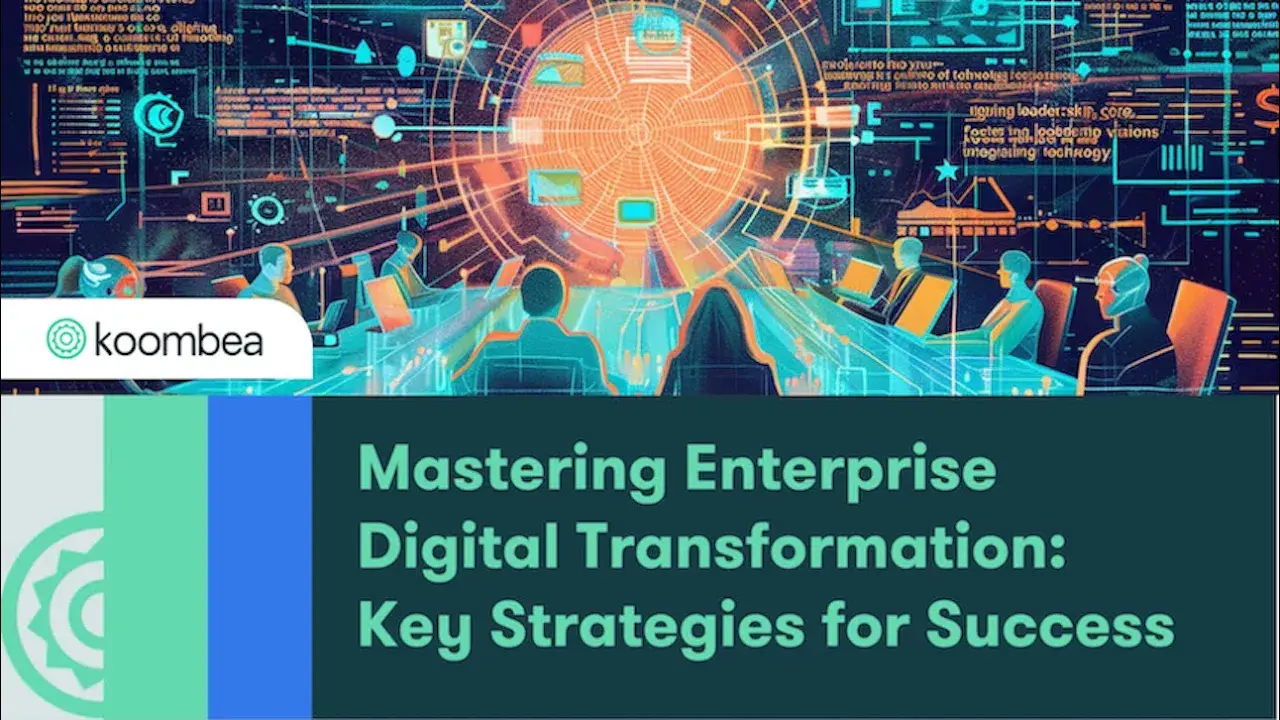
Embarking on the journey of enterprise digital transformation can seem overwhelming. Enterprises are tasked with embracing a digital-first approach, and the question arises: where to begin? This guide removes ambiguity by providing a brief roadmap for businesses using digital technology to transform operations and enhance customer value. It guides you through understanding what enterprise-level digital transformation entails, why it’s essential, and how to implement it effectively—preparing your company for an innovative future powered by cutting-edge technology.
Enterprise digital transformation: Key Takeaways
- Enterprise digital transformation is a comprehensive shift that involves redefining business operations with a customer-centric focus, enabled by the strategic adoption of digital technologies like AI and cloud computing.
- Successful digital transformation is a coordinated execution of solid leadership and vision, adaptable organizational culture, and strategic technology adoption and integration, all working to reshape the business for the digital future.
- The digital transformation process involves assessing current operations, developing a detailed roadmap with clear KPIs, and executing and monitoring the initiatives while overcoming challenges like change resistance and ensuring data security and privacy.
The Essence of Enterprise Digital Transformation
Digital transformation is fundamentally about a profound change in how companies do business and create customer value. It’s driven by a deliberate move to strategically incorporate digital technologies into their operations strategically, emphasizing placing customer needs at the forefront of these digital transformation efforts and, thereby, reshaping the core of how businesses function.
This continuous evolution shapes organizations into resilient structures designed to succeed and remain competitive even in an age dominated by digital advancements.
Defining Enterprise Digital Transformation
Digital transformation within an enterprise involves transitioning from conventional, sequential operational methods to a flexible and integrated system. This shift isn’t limited to simply converting current processes into digital formats. It also entails devising innovative business models that improve customer experiences.
Enterprises must consistently adapt their strategies and operations to stay competitive despite continuously evolving market trends, customer behavior, and consumer expectations.
The Role of Digital Technologies
Digital transformation outcomes are significantly influenced and facilitated by digital technologies such as AI, machine learning, and cloud computing. They provide enterprises with:
- Enhanced agility
- Increased mobility
- Greater flexibility
- The ability to make informed decisions in real-time
- Streamlined operational processes
Organizations should thoroughly integrate these technologies into their systems to achieve maximum effectiveness in guiding the entire digital transformation process.
Critical Components of Successful Digital Transformations

The essence of a successful digital transformation hinges on the harmonious interplay between three vital elements: robust leadership, a flexible corporate culture, and the deliberate implementation and assimilation of technology. These fundamental factors collaboratively propel the evolution of enterprise organizations towards becoming digitally oriented, thus preparing an enterprise for future digital landscapes.
Leadership and Vision
Leadership is pivotal in the sphere of digital transformation. Those at the helm, digital transformation leaders, are responsible for propelling this change forward by establishing a coherent vision and encouraging teamwork while cultivating an environment conducive to innovation. These visionaries connect what was and will be by eloquently defining the strategic direction of digital transformation trends and how it dovetails with overarching business goals.
These frontrunners acknowledge the crucial role of equipping their employees for forthcoming challenges, thus placing a significant emphasis on talent enhancement as a primary objective within their digital business transformation agenda.
Organizational Culture
A culture that has undergone digital transformation focuses on putting the customer first, fostering innovation, engaging in decision-making based on data analytics, and enhancing teamwork. This environment motivates teams to seek out fresh concepts and approaches while supporting ongoing adaptability and tenacity. Employees are encouraged to collaborate across different divisions within this culture for process improvement while being urged to educate themselves to stay abreast of technological progress continually.
Technology Adoption and Integration
Technology adoption and integration must be carried out strategically for a digital transformation to succeed. This involves ensuring operations improvement by aligning with the business’s goals and ensuring that the chosen technologies have scalability potential and customer expectations. AI, cloud computing, and automation are vital in streamlining business processes and elevating customer experiences.
It is also imperative for organizations to build capabilities internally while simultaneously establishing external partnerships that support the implementation of digital transformation initiatives.
Implementation Steps
Embarking on a digital transformation initiative involves a series of steps, such as evaluating the existing situation, crafting a strategic plan, and implementing and overseeing the efforts related to the digital transformation project. A crucial component in this process is executing effective strategies for digital transformation.
To Explore these actions, let’s look at each step more closely.
Assessing the Current State
Before embarking on the digital transformation process, conducting a thorough assessment of your situation is crucial. This includes an analysis of current technologies and methodologies to pinpoint improvement opportunities and eliminate antiquated procedures and legacy technology that may obstruct the execution of an effective digital transformation strategy.
Establishing a precise understanding of what digital transformation means for your organization is essential during this phase.
Developing a Roadmap
Developing a digital transformation roadmap is an essential component in the journey of transforming your business. This strategic plan must:
- Pinpoint specific issues or prospects for improvement
- Set forth precise objectives aligned with quantifiable Key Performance Indicators (KPIs)
- Designate required assets, encompassing budget provisions for new technologies, prospective staffing additions, and educational initiatives.
Execution and Monitoring
During the execution and monitoring phase, it’s crucial to put structured project management practices into practice. This involves meticulous planning, coordination, and implementation of initiatives that adhere to predetermined scopes, schedules, and financial constraints.
It is essential to consistently monitor key performance indicators (KPIs) and overall project advancement to ensure the transformation continues. Collecting and evaluating stakeholder feedback is critical for enhancing processes and legacy systems.
Overcoming Challenges
Digital transformation holds tremendous promise, yet it comes with its own set of obstacles. Companies typically need help with things such as reluctance to change, issues surrounding the security and privacy of data, and the necessity to synchronize the objectives of business operations with those of information technology.
To overcome these challenges, we should consider various tactics and strategies.
Managing Change Resistance
Overcoming the reluctance to adapt can be a significant obstacle when embarking on digital transformation projects. Such resistance often arises from fears among employees about mastering new technologies or anxieties over their job stability. To handle this challenge effectively, it’s essential to engage with employee fears, ensure focused communication is in place, and gain the support of middle management.
Ensuring Data Security and Privacy
In the era of growing digitization, safeguarding a company’s data is critical. To shield digital assets and proactively tackle data privacy risks, businesses must implement robust cybersecurity strategies and adhere to necessary protocols while remaining compliant with regulatory requirements concerning data protection.
Aligning Business and IT Goals
For a successful digital transformation, it is crucial to harmonize its business functions and IT aims. Ensuring this alignment helps deliver substantial value to the company and underpins its broader strategic ambitions.
Assessing return on investment (ROI) and confirming that key performance indicators (KPIs) are consistent with the organization’s strategic objectives is an integral part of digital transformation processes.
Real-World Examples of Successful Enterprise Digital Transformation
Exploring the practical aspects of these digital transformation strategies, we can look at a range of examples that showcase the tangible advantages of an all-encompassing digital strategy. Such instances reveal how companies can effectively steer through their journeys in digital transformation.
Future Trends
As we navigate the digital age, digital transformation remains a fluid and ever-changing domain, propelled by technological progress, key business scenarios, and shifting commercial demands. It’s crucial to explore emerging trends expected to shape the trajectory of future digital transformation initiatives as organizations undertake their journey toward digital evolution.
AI and Machine Learning
AI and machine learning technologies increasingly embed themselves across diverse industries, catalyzing substantial transformations in fields ranging from self-driving cars and ecological surveillance to cutting-edge production methodologies. The facilitation of automated procedures by artificial intelligence and the enhancement of efficiency by AI signify that these technologies have established a permanent presence.
Cybersecurity and Data Privacy
Enterprises are increasingly concerned about the sophisticated evolution of cybersecurity threats. In response to these heightened challenges, businesses proactively incorporate robust cyber defenses and actively manage data privacy risks.
The Rise of Remote and Hybrid Work
Digital transformation has become crucial in the wake of significant shifts toward remote and hybrid work models in today’s workplace, facilitating flexible work arrangements and supporting a global workforce that can operate anywhere from any location.
Summary
Digital transformation represents a fundamental shift in how businesses operate and deliver customer value. However, it’s not a one-size-fits-all solution. Each organization must chart its unique journey, considering its needs, goals, and challenges. While the journey might be complex and challenging, the rewards – improved efficiency, customer loyalty and satisfaction, and business growth – are well worth it.
Frequently Asked Questions
What are the three key enterprise benefits of digital transformation?
Enterprises gain enhanced efficiency, heightened agility, and superior customer experiences. These advantages can drive greater competitiveness and foster expansion.
What is the digital transformation enterprise strategy?
The enterprise strategy encompasses incorporating digital technology throughout every facet of a business, which results in essential modifications to how operations and structured data are conducted and how value is delivered to customers. Such a transformation necessitates an organizational cultural change that encourages challenging existing norms, experimentation, and accepting failure as part of the process.
Lean into this transition and spearhead innovation!
What are the four types of digital transformation?
Selecting the appropriate variety of digital solutions for transformation—be it operational, business model, organizational, or customer experience—is essential for achieving triumph in the evolution of your enterprise.
What is digital transformation?
Digital transformation represents a significant strategic realignment wherein enterprises embrace digital technologies and focus on customer-oriented approaches to enhance their operational processes and provide value. This shift is essential for keeping pace with the changing digital landscape.
What are some of the challenges in implementation?
Implementing digital transformation is often met with hurdles, including resistance to change, apprehensions about data security and privacy, and the necessity to synchronize objectives across business operations and information technology.
These issues must be confronted and managed appropriately to propel enterprise digital transformation effectively.
